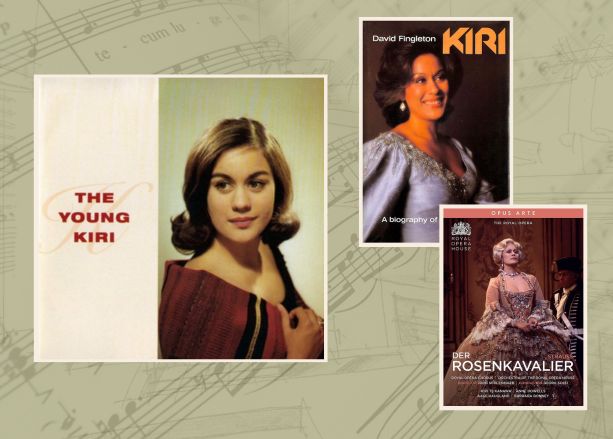Despite its geographical isolation from the traditional centres of the operatic world, Aotearoa New Zealand has produced a remarkable number of exceptional opera singers in the twentieth and twenty-first centuries and this tradition shows every sign of continuing. Of all these outstanding ‘southern voices’, the most immediately and internationally recognisable is Dame Kiri te Kanawa, who celebrated her eightieth birthday on Wednesday 6 March 2024. You can access tributes to, and interviews with Kiri te Kanawa via Radio New Zealand, including Playing Favourites with Dame Kiri Te Kanawa, Happy Birthday, Dame Kiri, Dame Kiri at 80, and Dame Kiri’s 80th birthday, a day of celebration.
Wellington City Libraries hold in their collection many recordings, both on CD and DVD, of performances by Kiri Te Kanawa, including fully staged operas, and song recitals; this blog will explore a handful of those recordings and other materials. More recordings are available via our online platforms which are both easily accessible using your library card number and PIN. Naxos Music Library offers a set of Mahler’s complete symphonies, recorded by the Boston Symphony Orchestra and Seiji Ozawa at the Tanglewood Festival; Dame Kiri appears as a soloist in Symphony No. 2 (with Marilyn Horne) and Symphony No. 4. Naxos Video Library makes available the 1976 studio film of Le nozze di Figaro, directed by Jean-Pierre Ponelle, with Hermann Prey as Figaro, Mirella Freni as Susanna, Maria Ewing as Cherubino, and Dietrich Fischer-Dieskau and Kiri Te Kanawa as the Count and Countess Almaviva.
Opera arias / Te Kanawa, Kiri
This four-CD set offers a true feast of singing, including ‘some of the acclaimed soprano’s most famous character portrayals’: the first disc offers arias from Turandot, Suor Angelica, and Pagliacci, alongside the lesser-known Mefistofele by Arrigo Boito (the poet and composer more readily known as one of Verdi’s librettists). Disc 2 devotes itself to Puccini with arias from Tosca, La rondine, Gianni Schicchi, among others. Disc 3 transports us to France, and the music of Charpentier, Debussy, Berlioz, and Offenbach, while disc 4 presents a variety of excerpts from German operas of the eighteenth, nineteenth, and twentieth centuries. Here, Dame Kiri reminds us of her peerless interpretation of ‘Ach, Ich Fuhl’s’ (Die Zauberflöte) and her sublime ease in the music of Strauss (‘Es gibt ein Reich’ from Ariadne auf Naxos and ‘Zweite Brautnacht’ from Die Ägyptische Helena). The extracts from Wagner’s Die Walküre, Tannhäuser, and Die Meistersinger von Nürnberg provide a different perspective of the singer in repertoire with which she has become less readily associated.
Searches for tradition: essays on New Zealand music, past & present
This 2017 publication presents fourteen essays exploring a variety of topics in New Zealand music, among them the development of jazz culture in New Zealand, the lives and work of immigrant colonial composers in the nineteenth century, Douglas Lilburn’s electroacoustic music, and the revitalization of taonga pūoro. The title draws on Lilburn’s address to the 1946 Cambridge Summer School of Music, ‘A Search for Tradition’. The contributing authors examine the ebb and flow of different traditions within New Zealand music and the changing ways these traditions have been studied. Jenny Wollerman’s chapter, ‘Shaping Traditions of Vocality: The Lyrical Legacy of Kiri Te Kanawa’ examines the singer’s ‘distinctive signature sound in the canon of professional vocal timbre’ and analyses her influence on the ‘vocal quality of lyric sopranos who followed her.’ Wollerman identifies the unique and distinct qualities of Te Kanawa’s voice, and how these qualities have been conceptualized and described; the descriptors ‘brilliance’ and ‘creamy warmth’ have often been applied to Te Kanawa’s voice, and Wollerman looks at the combination of physiology and technique that produces such sounds. She suggests also that these elements of Kiri Te Kanawa’s vocality have influenced other sopranos, notably Kathleen Battle, Barbara Bonney, and Renée Fleming as part of a ‘transmission of vocal aesthetics.’ This discussion informs and enhances our appreciation of the true magic of Kiri Te Kanawa’s voice.
 The marriage of Figaro / Mozart, Wolfgang Amadeus
The marriage of Figaro / Mozart, Wolfgang Amadeus
The Countess Almaviva in Mozart’s Le nozze di Figaro gave Kiri Te Kanawa immediate ‘legendary status’ after her debut in the role at the Royal Opera House, Covent Garden, in 1971. Two years later, her interpretation of this role was captured for posterity in a live film from the Glyndebourne Opera Festival. Much of the strength in this Glyndebourne production lies in the interactions between the Countess, Susanna ( Ileana Cotrubas), and Cherubino (Frederica von Stade), a youthful and energetic trio, rather outshining Figaro (Knut Skram) and Almaviva (Benjamin Luxon). However, given Mozart’s conviction that the women are the driving force in opera buffa, this is entirely appropriate: a review of the production in The Times noted that Cortrubas’s Susanna ‘left no doubt that she was the brains behind all the intrigue.’ Writing of Kiri Te Kanawa’s performance, the same critic said ‘She conquered her entrance aria, “Porgi amor”, as if its reputation for difficulty were a fairy story’ while her ‘Piu docile sono’ was ‘sung with true grandeur and nobility.’ (The Times, 24 July 1973). Under Peter Hall’s direction, this is an intimate and domestic Figaro, emphasising the ancien regime paradox between the close quarters in which masters and servants lived and the immense social gulf that separated them. Musically and visually, this Figaro is one to revisit as a record of a generation of inimitably gifted singers.
Der Rosenkavalier/ Strauss, Richard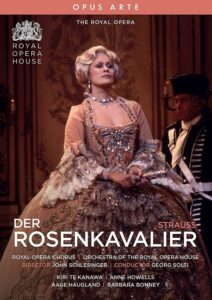
Recorded in 1985, this performance of Der Rosenkavalier marked the 25 anniversary of Georg Solti’s Covent Garden debut, conducting the same opera. Several reviews of Kiri Te Kanawa’s performance as the Marschallin in this production extol the same ‘creamy’ vocal qualities that Jenny Wollerman has highlighted in her essay in Searches for Tradition. After attending a performance during this 1985 season of Rosenkavalier, critic Bernard Levin wrote that Te Kanawa was ‘in glorious voice, ravishingly lovely tones [with] never a hint of pressure.’ Indeed, one of the glories of this performance, directed by John Schlesinger is hearing the contrast between the voices of the Marschallin, Octavian (Anne Howells) and Sophie (Barbara Bonney), especially in the final trio where these ‘three real human beings, snatched up by a cyclone of feeling, are working out their emotional destinies separately and together.’ Another highlight of this performance is the Danish singer Aage Haugland as Baron Ochs. Unlike other productions which emphasize the buffoonish qualities of Ochs, here Schlesinger and Haugland develop Ochs’s threatening and cruel elements a more threatening character, cruel rather than simply oafish. Under Solti, the Royal Opera House Orchestra offers fine playing, taut and energetic. The mise en scène and costumes are gratifyingly sumptuous.
 The young Kiri: the early recordings, 1964-70/ Te Kanawa, Kiri
The young Kiri: the early recordings, 1964-70/ Te Kanawa, Kiri
This two-disc set of Dame Kiri Te Kanawa’s early recordings offers a compelling aural portrait of the young singer, at the start of an extraordinary career. CD 1 is devoted to arias and art song, with Puccini especially well-represented in extracts from La bohème, Tosca, and Turandot, as well as showpiece arias from Johann Strauss’s Die Federmaus and Gounoud’s Faust among other treasures. CD 2 turns to musical theatre and popular songs, demonstrating Te Kanawa’s versatility in different styles of singing. Several ensembles and collaborating musicians also make an appearance: the NZBC Orchestra, organist Peter Averi, singer Hohepa Mutu, and harpist Dorothea Franchi.
Southern voices: international opera singers of New Zealand / Simpson, Adrienne
Adrienne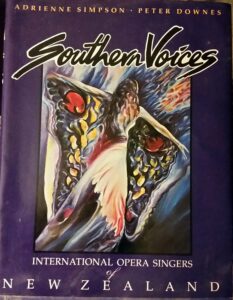 Simpson and Peter Downes dedicated this book to the singers it profiles. Southern Voices is a trove of insights into the careers and reflections of a succession of truly great artists, including Patricia Payne, Donald McIntyre, Anson Austin, Malvina Major, and Kiri Te Kanawa. The singers reflect on their early training and the formative experiences in local choirs and competitions that set them on the path to the most august heights of their profession. Simpson and Downes include a fascinating summary of Kiri Te Kanawa’s musical training and her career, from her earliest years in Gisborne when the unusually developed quality of her voice was recognised before she’d started school, to training in Auckland with Sister Mary Leo, competition success in New Zealand and Australia, and then the beginnings of a career in London. Simpson and Downes document that her trajectory towards stardom was not an easy one: they lay out vividly the stress of auditions, of learning new repertoire—sometimes under intense pressure— and finding the key to inhabiting new roles vocally and dramatically, as well as the logistics of international travel, performance, and maintaining the health of her voice. However, these hardships were offset by the tremendous reactions to Dame Kiri’s performances as the Countess in Figaro, Elvira in Don Giovanni, and Desdemona in Otello in the 1970s, and her further triumphs in Strauss roles in the 1980s. Southern Voices is a valuable record of the lives and careers of many singers, and to complement it, you may consider the accompanying CD Southern Voices featuring the singers profiled in the book; Kiri Te Kanawa sings ‘Piangero’ from Handel’s Giulio Cesare.
Simpson and Peter Downes dedicated this book to the singers it profiles. Southern Voices is a trove of insights into the careers and reflections of a succession of truly great artists, including Patricia Payne, Donald McIntyre, Anson Austin, Malvina Major, and Kiri Te Kanawa. The singers reflect on their early training and the formative experiences in local choirs and competitions that set them on the path to the most august heights of their profession. Simpson and Downes include a fascinating summary of Kiri Te Kanawa’s musical training and her career, from her earliest years in Gisborne when the unusually developed quality of her voice was recognised before she’d started school, to training in Auckland with Sister Mary Leo, competition success in New Zealand and Australia, and then the beginnings of a career in London. Simpson and Downes document that her trajectory towards stardom was not an easy one: they lay out vividly the stress of auditions, of learning new repertoire—sometimes under intense pressure— and finding the key to inhabiting new roles vocally and dramatically, as well as the logistics of international travel, performance, and maintaining the health of her voice. However, these hardships were offset by the tremendous reactions to Dame Kiri’s performances as the Countess in Figaro, Elvira in Don Giovanni, and Desdemona in Otello in the 1970s, and her further triumphs in Strauss roles in the 1980s. Southern Voices is a valuable record of the lives and careers of many singers, and to complement it, you may consider the accompanying CD Southern Voices featuring the singers profiled in the book; Kiri Te Kanawa sings ‘Piangero’ from Handel’s Giulio Cesare.
Vier letzte lieder ; 13 lieder / Strauss, Richard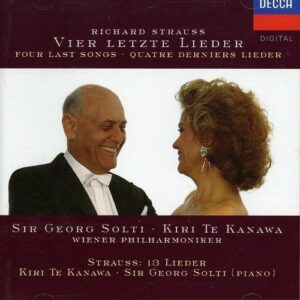
Renowned for her performances of Strauss roles—the Marschallin in Der Rosenkavalier, the title role in Arabella, and Countess Madeleine in Capriccio—Kiri Te Kanawa’s interpretations of Strauss’s Vier letzte Lieder (Four Last Songs) have long been acclaimed as definitive for their sensitivity to the elegiac qualities of the songs, combining tenderness, eloquence, and avoidance of sentimentality. Here she is joined by Georg Solti, not on the podium but at the piano, and one of the joys of this recording is that it captures Solti’s skill as a pianist, negotiating the complexities of Strauss’s music with ease. As a young conductor, Solti had met Strauss three times, and conducted the final trio of Der Rosenkavalier at the composer’s funeral; here, his lifetime of immersion in Strauss’s music is apparent and makes for a moving and intimate performance.
Maori songs / Te Kanawa, Kiri
Recorded in 1999 in Auckland’s Revolver Studio and London’s Abby Road as an album to greet the new millennium, Kiri: Māori Songs features Kiri Te Kanawa alongside the Abby Road Ensemble and a star-filled choir including Robert Wiremu and Mahinaarangi Tocker. Many of the songs will be familiar, the majority dating from the first decades of the twentieth century, some melding elements of traditional waiata with popular European song, some transliterated arrangements, and others newly composed. There are two songs attributed to the great contralto Fanny Rose Howie —‘Hine e hine’ and ‘Hoki, hoki tonu mai’—alongside such classics as Pōkarekare ana and ‘Po atarau’ (‘Now is the Hour’). The sixteen songs, exhibiting careful balance between soloist Kiri Te Kanawa and her accompanying singers and musicians, constitute a beautifully presented and sung recital.
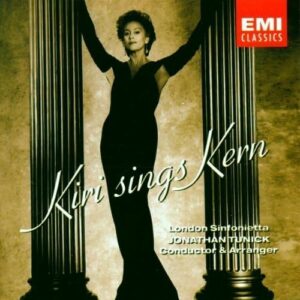 Kiri sings Kern / Kern, Jerome
Kiri sings Kern / Kern, Jerome
Jerome Kern (1885–1945) created dozens of works for Broadway and Hollywood, some of which are now largely forgotten except for a few songs, but others have endured throughout the decades, especially Show Boat and Swing Time. In this 1993 album, with the London Sinfonietta and conductor/arranger Jonathan Tunick, Kiri Te Kanawa brings nuance and gorgeous tone to Kern’s songs, while the London Sinfonietta provides expert accompaniment in Tunick’s arrangements. Alongside such Kern classics as ‘The Last Time I Saw Paris’ and ‘Smoke Gets in Your Eyes’ are some relative rarities, all serving as reminders of Kern’s inimitable panache as a songwriter.
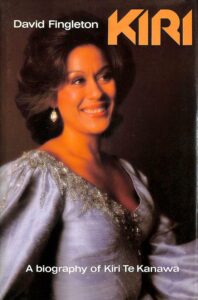 Kiri Te Kanawa : a biography / Fingleton, David
Kiri Te Kanawa : a biography / Fingleton, David
Published in 1982, this biography of Kiri Te Kanawa provides insights into the singer’s early career. Author David Fingleton (1941–2006) was a barrister, who, for some years, was a member of the same Inner Temple chambers as John Mortimer, the creator of Rumpole. Fingleton was also a music and opera critic for several publications, and associate editor of Music and Musicians magazine for a time. Fingleton’s biography of Dame Kiri covers her early training and career, focusing on the extraordinary decade 1971–1981 which saw her conquer Covent Garden and the Metropolitan Opera, stunning audiences and critics with her extraordinary voice and ability to inhabit her roles dramatically. As a biography, Fingleton’s work here is perhaps not the most authoritative, but his depth of operatic knowledge gained as a critic and, more importantly, as a listener, allowed him to capture and communicate the brilliance and intensity of this uniquely gifted singer.
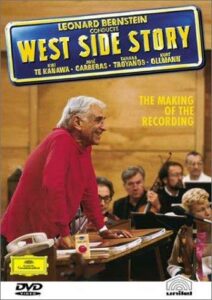 Leonard Bernstein conducts West Side Story: The Making of the Recording
Leonard Bernstein conducts West Side Story: The Making of the Recording
Writing about the lengthy genesis of West Side Story, Leonard Bernstein noted the difficulties of ‘making a musical that tells a tragic story in musical comedy terms . . . [while] never falling into the “operatic” trap’. The production team did not want to populate the stage with well-known stars for the original Broadway show in 1957, and Bernstein recalled that: ‘We had the really tough problem of casting…because the characters had to be able not only to sing but dance and act and be taken for teenagers. Ultimately, some of the cast were teenagers, some were 21, some were 30 but looked 16. Some were wonderful singers but couldn’t dance very well, or vice versa … and if they could do both, they couldn’t act.’ Eventually, an outstanding cast was formed, and the audio recording of these artists has become a musical theatre classic. In 1984, despite the earlier determination that West Side Story was not for opera singers, Deutsche Grammophon brought together a stellar cast — including Kiri Te Kanawa (Maria), Kurt Ollmann (Riff), José Carreras (Tony), and Tatiana Troyanos (Anita) — to make a studio recording of West Side Story with orchestra, conducted by the composer. The Making of the Recording documents the sometimes tense rehearsal and recording process interspersed with short interviews, including Dame Kiri talking about the exhilarating experience of recording West Side Story with the composer. While these performers are not teenagers, and neither do they attempt to impersonate them, their voices give a stunning account of Bernstein’s music.
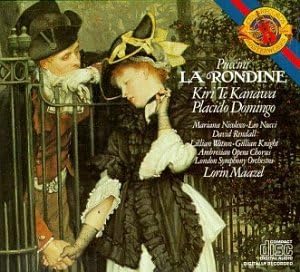 La rondine / Puccini, Giacomo
La rondine / Puccini, Giacomo
In 1913 the management of the Carltheater in Vienna asked Puccini to write an operetta. He agreed in principle, wanting to devise something akin to Strauss’s Rosenkavalier although ‘more amusing and more organic’. The result was La rondine, the story of Magda (the titular rondine or swallow) who leaves her protector Rumbaldo for the young and impressionable Ruggero. When naive Ruggero, not realising that Magda is a demimondaine, indicates that his mother has approved his desire to marry Magda, she knows she must renounce him and return to her previous life. Puccini set the opera in Second Empire France, the action moving between Paris and the Côte d’Azur. The outbreak of war in 1914, and Italy’s 1915 entry into the war against the Austro-German forces disrupted plans for a Viennese premiere; the first performance took place instead at the Théâtre de l’Opéra in Monte Carlo on 27 March 1917. Puccini subsequently made significant alterations to La rondine in 1917 and 1918. The result is a light, elegant, yet ultimately melancholic opera coloured by Parisian rather than Viennese waltzes. This studio recording from 1983 offers Kiri Te Kanawa as Magda and Placido Domingo as Ruggero, alongside fellow principals Leo Nucci (Rumbaldo), David Rendall (Prunier) and Mariana Nicolesco (Lisette). All the singers, as well as the London Symphony Orchestra and Ambrosian Opera Chorus, are in excellent form, while Lorin Maazel’s conducting is sensitive to the different moods of the piece and avoids any descent into sentimentality.


